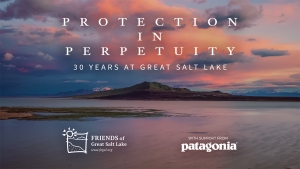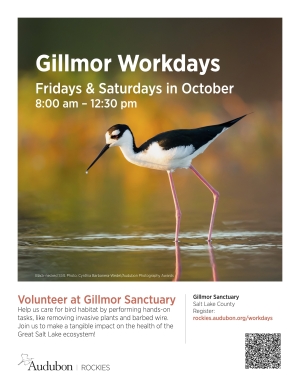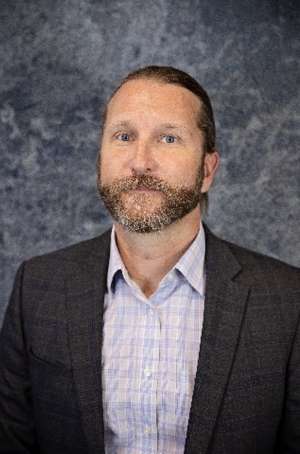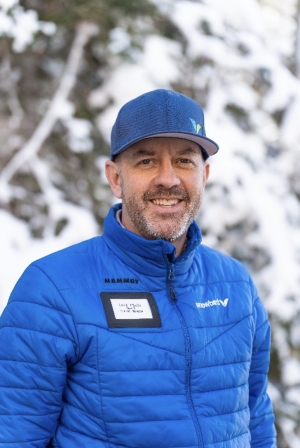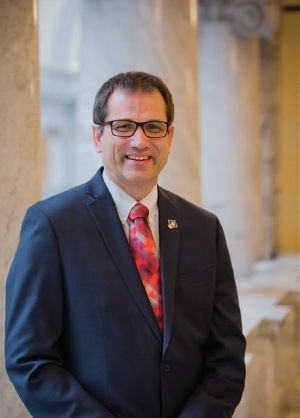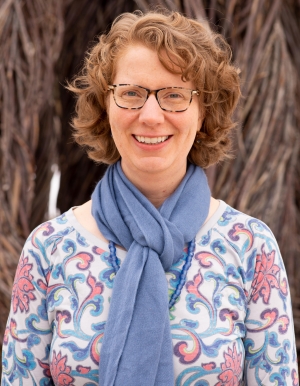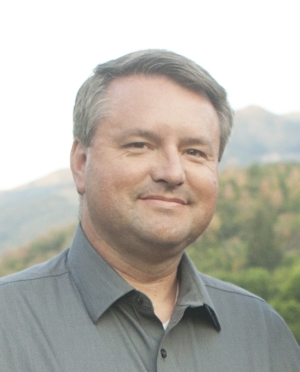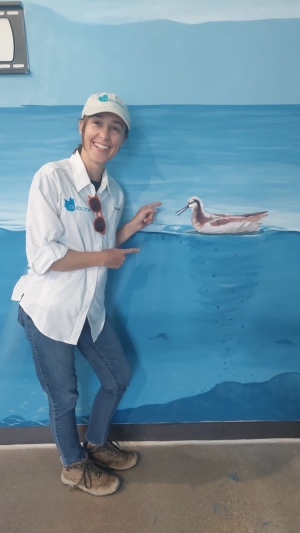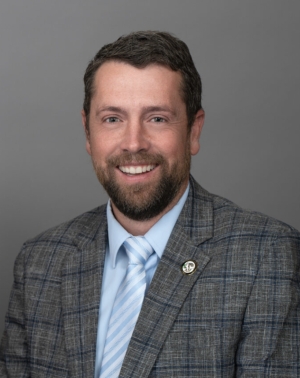Katie
Watch our 30th Anniversary Film: Protection in Perpetuity
For 30 years, FRIENDS has worked to protect Great Salt Lake's dynamic ecosystem. As we celebrate the progress made and the work ahead, we invite you to be a part of this legacy.
To learn more about our work, watch our 30th anniversary film, Protection in Perpetuity:
Help support our continued education, research, advocacy, and arts programming by making a year end donation here.
Gillmor Sanctuary Workdays with Audubon
Audubon’s Gillmor Sanctuary has announced new volunteer events this October!
Help care for important bird habitat along Great Salt Lake by performing hands-on tasks, like removing invasive plants and barbed wire.
Workdays are held each Friday and Saturday of October.
Register here: https://act.audubon.org/a/gillmor-sanctuary-workdays-fall-2024
Josh Brown
Senior Director of Governmental Affairs
Utah Manufacturers Association
Bio:
Josh Brown has a strong breadth of knowledge in manufacturing, mining, regulatory, environment, and natural resource policy. Having served as chairman of the Utah Manufacturers Association in 2018 and 2019 and being an executive board member of the association, Josh brings a unique, real-world application of manufacturing both in the hands-on operations and external policy/regulatory impacts.
Before UMA, Josh worked at Rio Tinto Americas, Rio Tinto Kennecott, and Resolution Copper for nearly 18 years. Over the past 14 years, he has managed and supported Kennecott’s governmental needs for county, state, and federal endeavors. Josh joined Rio Tinto in 2006 at Kennecott Utah Copper as a member of the Business Improvement team. During that time, he has served as a manager of Business Improvement, Master Black Belt at various Rio Tinto business units, Six Sigma/Lean Instructor, and special projects leader.
Prior to mining, Josh worked in food processing and medical device manufacturing. Work in manufacturing includes process engineering, new product development, design patents, regulatory compliance, and business improvement.
Josh holds a BS in Chemical and Fuels Engineering from the University of Utah, a Master of Business Administration from Westminster College, and a certified Business Improvement Six Sigma Master Blackbelt.
Title: Great Salt Lake Business Council: Engaging the Business Voice
Abstract: Many Utah businesses are deeply concerned about Great Salt Lake but have struggled to access good, real-time information and know how best to engage. This growing group of Utah businesses and trade organizations are working together to make sure Utah’s business voice is heard when it comes to efforts to conserve water and to protect Great Salt Lake. Tim Hawkes and other members of the Business Council will share an update on this effort and explain why business engagement is vital to help sustain the Lake.
Dave Fields
President and General Manager
Snowbird Resort
Bio:
Dave Fields is the President and General Manager of Snowbird Resort in Utah. A native of Salt Lake City, Dave joined Snowbird in 2000 and has held a variety of positions at the year-round mountain resort. After 10 years of working in Snowbird’s Public Relations, Marketing and Ticketing, he was named Vice President of Resort Operations in 2010. Dave became Snowbird’s General Manager in 2017, and in 2018, was named President and General Manager. Dave is a graduate of the University of Utah and has two children, Charlie and Meredith, with his wife Melissa. Dave currently serves on the boards of Ski Utah, Wasatch Adaptive Sports and National Ski Areas Association.
Title: Great Salt Lake Business Council: Engaging the Business Voice
Abstract: Many Utah businesses are deeply concerned about Great Salt Lake but have struggled to access good, real-time information and know how best to engage. This growing group of Utah businesses and trade organizations are working together to make sure Utah’s business voice is heard when it comes to efforts to conserve water and to protect Great Salt Lake. Tim Hawkes and other members of the Business Council will share an update on this effort and explain why business engagement is vital to help sustain the Lake.
Dina Blaes
Director of Regional Development
Salt Lake County
Bio:
Dina Blaes is the Director of Regional Development at Salt Lake County, responsible for leading the County's efforts in Planning, Transportation, Housing, Community Development, Canyons Management, Sustainability and Economic Development. She came to Regional Development after serving as Associate Deputy Mayor of Finance and Administration under Salt Lake County’s CFO.
Prior to joining the County, Dina spent more than a decade as a consultant providing comprehensive urban planning and historic real property-related services to clients in the Intermountain West. She studied Architecture and Environmental Design at Parsons School of Design and holds a BA from Columbia University in Art & Architectural History. She also received a master’s degree in City & Metropolitan Planning from the University of Utah. She was the Chair of the Utah Board of State History, serves on the Great Salt Lake Advisory Council and represents the SLCo Mayor on the Jordan River Commission and the Wasatch Front Regional Growth Commission.
Dina was born and raised in Salt Lake City and currently lives in Millcreek City.
Title: The Importance of GSL Shoreline Protection in Water and Land Use Planning
Abstract: In Salt Lake County’s West General Plan (adopted May 2022), the term “Great Salt Lake Shoreline Heritage Area” was introduced. The area accounts for nearly 34,000 acres of the general plan study area and when the plan was adopted, most landowners and land managers in the area opposed commercial development in favor of maintaining habitat conservation, ranching, and agricultural uses into the future. Farmers and ranchers who work in the area described the relationship between the existing land uses as symbiotic. The West General Plan calls for future land uses to remain as bird refuges, habitat conservation, waterfowl habitat, and agriculture by employing a variety of conservation tools, including fee simple acquisition, conservation development agreements, purchase or transfer of development rights, grazing or agricultural servitudes, and conservation easements. Development pressures in the GSL Shoreline Heritage Area are increasing. Can a coalition of interested parties affect the course of events?
Ray Ward
Utah House of Representatives
Bio:
Representative Ray Ward is a family physician with a PhD in pharmacology. He has been representing Bountiful and West Bountiful in the Utah House of Representatives since 2015. He serves on the House Health and Human Services Committee, the House Transportation Committee, and the Social Services Appropriations Subcommittee. He has worked to support changes to the way we use, measure, and conserve water so we can have enough to preserve a healthy Great Salt Lake.
Title: The Dust Never Seems to Settle for Long These Days: What We Talk About When We Talk About Dust: Shared Goals, Lessons Learned, and Opportunities for Future Work
Abstract: Dust from desiccating saline lakes can have significant impacts on the environment, air quality, human health, and the economy. Yet, there's no one-size-fits all approach to monitoring, measuring, or mitigating dust emissions from dry lakebeds. At the last Issues Forum, we listened to experts describe their efforts at Owens Lake, Mono Lake, and Salton Sea. How have their findings and advice impacted investigations of dust in our own backyard? What are our current knowns and unknowns about dust emissions from the dry lakebed of Great Salt Lake? Join us for a collaborative presentation and panel discussion of how we've been working to better understand the social and environmental impacts of dust and what research and management opportunities lie ahead.
Karin Kettenring
Professor of Wetland Ecology, Department of Watershed Sciences
Utah State University
Bio:
Dr. Karin Kettenring is head of the Wetland Ecology and Restoration Lab in the Department of Watershed Sciences at Utah State University. She has a B.A. in Biology from Oberlin College and a Ph.D. in Applied Plant Sciences from the University of Minnesota. She has been a faculty member at Utah State University since 2008. Her research program focuses on increasing capacity for effective wetland management and restoration throughout the Intermountain West through research on the ecology and genetics of wetland plant invaders and native wetlands plants. Much of her research program involves meaningful collaborations with wetland managers, restoration practitioners, and native plant vendors.
Title: Strategic management, innovative research, and strong collaborations drive the success of Phragmites control and wetland restoration in a new water reality
Abstract: Great Salt Lake wetlands are a critical part of the world-renowned Great Salt Lake ecosystem. The valuable role these wetlands play, however, is under threat due to dewatering, hydrologic extremes, and invasive species. Yet, solutions developed to effectively manage and restore these wetlands can serve as a model for other wetlands around the world facing similar impacts. Here, we highlight recent successes and ongoing challenges for the management and restoration of Great Salt Lake wetlands. We emphasize the essential role that collaborations across management agencies and land owners have played in ongoing progress as well as unique partnerships between managers and researchers. We focus on the omnipresent impacts of the invasive, non-native grass phragmites; the innovative research program in collaboration with many agencies that helped refine today’s management strategies; and the massive, highly coordinated management program that is yielding greatly reduced phragmites cover throughout the watershed. However, water shortages will hinder further reductions in phragmites as will landowners who are unable or unwilling to manage their invasive species. We then turn our attention to the restoration of native plant communities, the essential next step in recovering these degraded wetlands and the habitat they provide. Active revegetation in wetlands has lagged behind progress made in invasive species management but opportunities abound to develop and refine best practices for seeding and planting, with researchers and managers again working in collaboration. Questions such as which species to introduce, at what density and time of year, and with what seed pre-treatments are being addressed in ongoing restoration experiments. Looking ahead, water availability will constrain how much wetland habitat can be restored through seeding and planting, as will access to diverse native wetland seeds that are affordable. We remain optimistic about the future of Great Salt Lake wetlands but underscore the vital importance of securing sufficient water, obtaining enough funding, and supporting strong collaborations for effective management and restoration.
Mark Reynolds
Lithium Process Manager
US Magnesium
Bio:
Mark Reynolds’ career spans over three decades, and includes a wide range of industrialmanufacturing sectors such as mining, paint, fertilizer, rocket fuel and now lithium. Prior to his current role, Mark held key positions at Sherwin-Williams, Compass Minerals, and Northrop Grumman, where he commissioned new plants, led production teams and improved process efficiencies. In 2020, US Magnesium built a lithium carbonate production facility that uses salts, recycled from the magnesium metal process, as its raw material. Mark has been employed by US Magnesium since 2021 and is responsible for providing technical support to the lithium carbonate plant and overseeing solar pond operations. Mark has over 12 years of experience working on Great Salt Lake (GSL) and enjoys serving on the Great Salt Lake Salinity Advisory Committee, interacting with a variety of folks representing the diversity of beneficial uses that the Lake supports. Mark earned his B.S. in Chemical Engineering from Brigham Young University.
Title: The Future of Great Salt Lake Mineral Extraction
Abstract: For over 50 years, the mineral extraction industries have partnered with the State ofUtah and other interests on the Lake to responsibly produce products vital to our health, safety and way of life, generating millions of dollars in taxes, fees and royalties and creating generations of jobs for the citizens of Utah. These activities have an impact on the Lake, but that impact is better understood when looked at in context with natural GSL evaporation and the need for annual salt removal to protect salinity levels. Now, in the midst of another Lake level crisis, lithium battery demand has sparked new interest in GSL mineral extraction and new extraction technologies. Over the past three years of lithium production, US Magnesium has gained a unique perspective on the challenges of lithium extraction and the applicability of Direct Lithium Extraction (DLE) technologies to other minerals in GSL. The mineral extraction industry understands that its destiny is inextricably tied to the health of the Lake. We continue with our commitment to innovation and adaptation to remain viable and a reliable partner on GSL.
Marcela Castellino
Saline Lakes Conservation Specialist
Manomet
Bio:
Marcela has been part of the WHSRN team and the Manomet Flyways Program since 2019. Within the team, her role is linked to the conservation of saline lakes and the focal species of her work is the Wilson’s Phalarope. She has experience working with the species since 2012, including two summers working at Great Salt Lake almost 10 years ago. Marcela has focused in recent years on strengthening ties between partners of different saline lakes in the Western Hemisphere, especially those that are part of WHSRN, including Great Salt Lake. To this end, she coordinates, participates, and supports research, monitoring, education, and community involvement projects all related to Wilson’s Phalarope.
Title: Current Situation of the Wilson’s Phalarope: A Review at the Hemispheric Level
Abstract: The conservation of species that depend on diverse sites throughout an extensive geographic region, as is the case of Wilson's Phalarope, is challenging not only from an ecological point of view, but also from a social, political, economic, and cultural. I’ll share briefly about the numerous threats that the species faces throughout its distribution in the American continent, that were identified and shared in the updated version of the Conservation Plan for the species. All of these must be considered when planning and implementing conservation and research actions. However, some of these threats stand out as likely to have dramatic and immediate effects on the species globally, with major direct negative consequences on the survival of Wilson's Phalarope. More immediate actions are required to avoid negative consequences for the species in the short term. This presentation is also a review of what a diverse group of people working with the species and members of the International Phalarope Working Group have advanced about monitoring and researching the species on a hemispheric scale, as well as which are the most important points that we consider should be addressed shortly to guarantee its conservation, ensuring thus the conservation of the saline wetlands that are their home.
Casey Snider
Representative, District 5 and House Majority Assistant Whip
State of Utah
Bio:
Born and raised in Liberty, Representative Snider now resides on a farm in Paradise with his wife Kelli, and their two children—both places he proudly calls home. A husband, father, volunteer firefighter, EMT, and avid sportsman Representative Snider recently added another title to his list of many: House Majority Assistant Whip.
Since being elected in 2018 to represent District 5 of Cache Valley, he views his time in the State Legislature as another opportunity to give back. He has produced legislative solutions at every level of government, from grassroots efforts to being a staffer at the U.S. Capitol. Representative Snider has championed policies concerning the preservation of Utah’s precious natural resources, specifically the future of our water supply. He’s known for his willingness to engage, an emphasis on common sense policy, and providing a valuable rural perspective.
Raised in agriculture, he’s integrated that ‘work until the job is done’ attitude the farm requires into his service with the legislature. A proud Aggie, Representative Snider earned a Bachelor of Science degree in conservation and restoration ecology, law, and constitutional studies from Utah State University and a Master of Science in environmental science and policy from Johns Hopkins University.
When he’s not working, he’s likely taking his daughter on a mule ride, going waterfowl hunting, or starting a new project on the farm.
Title: Turning the Tide: Legislative Perspectives and Solutions to Navigating Water Policy: Lakeside Chat with Speaker Mike Schultz and Rep. Casey Snider
Abstract: Utah’s future depends on smart and sustainable water policies. The Legislature has taken a hands-on approach to protecting, enhancing, and preserving Utah’s water systems and resources. Join Speaker Mike Schultz and Representative Casey Snider as they discuss water, conservation, and Great Salt Lake policies from the 2024 General Legislative Session.

